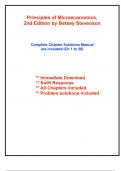Principles of Microeconomics,
2nd Edition by Betsey Stevenson
Complete Chapter Solutions Manual
are included (Ch 1 to 20)
** Immediate Download
** Swift Response
** All Chapters included
** Problem solutions included
,Table of Contents are given below
Chapter 1 The Four Core Principles of Economics
Chapter 2 Demand and Consumer Choice
Chapter 3 Supply and Producer Choice
Chapter 4 Equilibrium: Where Supply Meets Demand
Chapter 5 Elasticity: Measuring Responsiveness
Chapter 6 Taxes, Price Controls, and Quantity Regulations
Chapter 7 Welfare Economics: Evaluating Market Efficiency and Market Failure
Chapter 8 Comparative Advantage and Gains from Trade
Chapter 9 International Trade
Chapter 10 Externalities and Public Goods
Chapter 11 The Labor Market
Chapter 12 Why Wages Vary: Workers, Jobs, Institutions, and Discrimination
Chapter 13 Inequality, Poverty, and Social Insurance
Chapter 14 Market Structure and Degrees of Market Power
Chapter 15 Entry, Exit, and Long-Run Profitability
Chapter 16 Price Discrimination and Sophisticated Pricing Strategies
Chapter 17 Economics of Strategic Management
Chapter 18 Game Theory and Strategic Choices
Chapter 19 Decisions Involving Uncertainty
Chapter 20 Decisions Involving Private Information
,Solutions Manual organized in reverse order, with the last chapter displayed
first, to ensure that all chapters are included in this document.
(Complete Chapters included Ch20-1)
[Chapter 20 (Micro 20; N/a Macro): End-of-Chapter Solutions]
Study Problems
Problem 1
1. You are thinking about funding a Kickstarter campaign for a hybrid mechanical/digital
calendar for which you’re willing to pay $125. To receive a calendar, the company required that
you pledge $100. You think there’s about an 80% chance of the company succeeding, but if the
product fails, you will not receive a refund. Is this a fair bet? Would you pledge the $100? Hint:
Use your consumer surplus if the company succeeds to evaluate the bet.
Solution 1
1. Yes, this is a fair bet. If the company succeeds, you received $125 − $100 = $25 of consumer
surplus. If the company succeeds, you are out $100. Given the probabilities the expected value is
0.8(125 − 100) + 0.2(0 − 100) = 0.8(25) − 0.2(−100) = 20 − 20 = 0. A fair bet is a gamble that
will, on average, leave you with the same amount of wealth (consumer surplus in this example).
Whether the student will or will not take the bet is entirely dependent on their risk preferences.
Risk-averse students wouldn’t take the bet as they prefer the certainty of not taking the gamble.
Problem 2
2. You are considering investing $2,000 in the stock market. If you invest, there is a 30%
probability that your investment will be worth $3,000 in one month and a 70% probability that
your investment will be worth $1,500 in one month. Alternatively, if you did not invest, you
simply keep the $2,000. Would you invest? What does your decision indicate about how you
view risk?
, Solution 2
2. If you decide to invest in the stock market then your expected income will be (0.30 × $3,000)
+ (0.70 × $1,500) = 900 + 1,050 = $1,950. Since this is less than the $2,000 you would have with
certainty if you did not invest, it is not possible to identify whether you are risk averse, risk
neutral, or even risk loving. If, however, the expected earnings from investing were greater than
$2,000, then your decision not to invest would indicate that you are risk averse.
Problem 3
3. You are analyzing two possible stock market investment strategies. For each of the following,
identify whether or not it would be classified as a fair bet. Would a risk-averse person make
either of these investments? Why or why not?
a. One strategy is to invest in a blue chip stock like Microsoft that has a proven track record.
There is a 25% chance that the company continues its steady growth and your wealth increases
by $30,000. There is a 75% chance that the company become unprofitable and your wealth
decreases by $10,000.
b. Another strategy is to invest in a start-up. There is a 10% chance that the company is a success
and your wealth increases by $100,000. However, there is a 90% chance that the company fails
and your wealth decreases by $20,000.
Solution 3
3.
a. Yes, this would be a fair bet. There is a 25% chance that your wealth will increase by $30,000
and a 75% chance that your wealth will decrease by $10,000. So, your expected change in wealth
will be ($30,000 × .25) + (−$10,000 × .75) = $7,500 + (−$7,500) = $0. So, on average, investing
in the stable company will leave your wealth unchanged. However, a risk-averse person would
not make this investment even though it is a fair bet. A risk-averse person will never accept a fair




